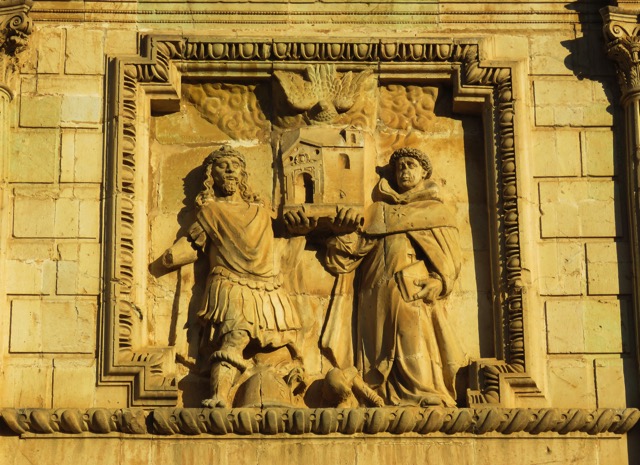We woke up fairly early and had breakfast at the hotel. It was a buffet as I had expected, and it was about as good as I expected. Still, it was pleasant enough sitting there having coffee overlooking the garden.
We went into the city and found our barbershop. I am not quite sure why we did not get any pictures here. The people who cut our hair knew little English, but they knew far more about cutting men’s hair than the folks at our local Great Clips. I must admit to a certain nervousness whenever a straightedge razor is applied to my neck, but the cleanness of the trim is amazing.
We went to one of the most famous churches in Mexico after this, Santo Domingo de Guzman, the old Dominican monastery church. This structure covers most of a large city block and it was once larger. The facade of the church is beautiful,
but it is the interior that is truly the most impressive.
It is not simply the amount of gold leaf that has been applied here, but the charm of the carvings which mix both Spanish and indigenous styles.
It’s not surprisingly a popular spot for weddings.
But we were not here primarily for the church. Instead, we were interested in the state culture center that now occupies the old convent. This is a fairly recent addition to Oaxaca’s cultural treasures. The Dominican monastery was closed in the 1850s as part of La Reforma, and in the aftermath of the Conservative defeat in the three year civil war that followed, the friars’ quarters were turned into military barracks. While the building was returned to the Dominicans during the administration of President Lázaro Cárdenas, the building was generally leased to the local university for classrooms. In the late 1990s plans were made to restore it as much as possible and to make it an important regional museum. Additionally, the old cloisters and walled garden enclosures have been turned into a botanic garden showcasing the native plants of the state.
It’s interesting to wander through this old building. Parts of it are still somewhat ornate.
But most of it is quite plain. But that is interesting, too.
Looking at the views out the windows may be the best part.
Of course, there is a lot of religious art here.
The museum houses Oaxaca’s oldest library, an important source of information about the colonial era and the early years of independence.
The botanic gardens are available only by guided tour. English tours are offered only two days a week, and today, alas, was not one of them. So we went along on a Spanish tour. Our guide, fortunately, knew how to speak clear, simple Spanish that people like me would understand. So I followed the tour and felt prtty good about my skills in this language.
Oaxaca had many different ecosystems. The state is largely mountainous. On the south, Oaxaca is open to the Pacific and has the typical climate of Mexico’s southern coast — hot, wet summers and warm, dry winters. Much of this summer precipitation falls on the mountains which is still fairly thickly forested. Another mountain ranger is found on the north east side of the state bordering Veracruz. During the summer tropical storms drench the mountains here. In the middle of the state is a long, fairly flat, central plateau. On the lee side of both ranges, this valley is fairly arid but sustains a significant amount of agriculture.
Cactus is one of the most iconic plants of the central valley. The garden showcased the cactus quite effectively.
Cactus is amazingly photogenic.
The section devoted to tropical plants was interesting, but other than a few bromeliads, it just looked like big trees with a lot of leaves.
There was also a large section devoted to cultivated plants, particularly corn. This is what corn looked like before people started to cultivate it.
Doesn’t look much like an Iowa farm, does it? The native peoples of this area learned to alter the plant until the ears looked like this
or this.
Certainly much more interesting than those big yellow things you find in an American grocery store.
Along the way, as our guide talked, we rested
and admired the historic building.
After the tour, we stopped by the Camino Real hotel. This was once known as the El Presidente, and when John and I stayed here twenty odd years ago it was the first time we had ever stayed at a hotel where they turned down your bed and put a chocolate there! It was once a convent for Dominican nuns and has been exquisitely restored. The courtyards are particularly lovely
and appealing to different kinds of guests!
We went back to our modern hotel and rested. In the evening we went back to town. We somehow found ourselves on a square we had never seen before. This area was not quite as well-restored.
But as night fell we noticed that this area was kind of a trendy area, not four tourists but for locals.
Today is the night before The Epiphany. In Mexico this holiday is Three Kings Day and it is the culmination of the Christmas season. Mexican children get presents on Three Kings Day, not Christmas. So the plaza area by the cathedral was packed with families. There was a place where the kids could get their pictures taken with the biblical figures. But others seemed more interested in having a family photo with superheroes for the day.
Tomorrow, it’s back to Los Angeles and reality.

























